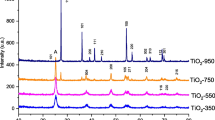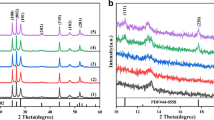Abstract
Sodium gadolinium molybdate (Na0.5Gd0.5MoO4) powder as a new photocatalyst was prepared using GdCl3·6H2O, H2NCSNH2 and Na2MoO4·2H2O as raw materials by hydrothermal approach. The as-synthesized products were characterized with XRD, FESEM, XPS, Raman, FTIR, BET surface area analysis, UV–Vis absorption spectra and PL spectroscopy, respectively. The photocatalytic performance of Na0.5Gd0.5MoO4 catalysts was assessed using the photocatalytic degradation of rhodamine B (RhB) at room temperature under visible light. The Na0.5Gd0.5MoO4 catalyst exhibited enhanced photoability as the Gd3+ ions increase. The excellent photocatalytic performance for photocatalysts arise from the separation and migration of the electron–holes pairs in the structure and the narrow band gap energies resulting in the visible absorption ability’s improvement. Additionally, the h+ was discovered to be the most significant reactive group for RhB photodegradation and the possible photocatalytic mechanism was also devised.









Similar content being viewed by others
References
Oller I, Malato S, Sánchez-Pérez JA (2011) Combination of advanced oxidation processes and biological treatments for wastewater decontamination - A review. Sci Total Environ 409(20):4141–4166. https://doi.org/10.1016/j.scitotenv.2010.08.061
Kumar SG, Devi LG (2011)Review on modified TiO2 photocatalysis under UV/visible light: selected results and related mechanisms on interfacial charge carrier transfer dynamics. J Phys Chem A 115(46):13211–13241. https://doi.org/10.1021/jp204364a
Han F, Kambala VSR, Srinivasan M (2009) Tailored titanium dioxide photocatalysts for the degradation of organic dyes in wastewater treatment: A review. Appl Catal A: Gen 359(1–2):25–40. https://doi.org/10.1016/j.apcata.2009.02.043
Chen HPH, Wei TC (2017) Well incorporation of carbon nanodots with silicon nanowire arrays featuring excellent photocatalytic performances. Phys Chem Chem Phys 19:11786–11792. https://doi.org/10.1039/C7CP01674C
Bhatkhande DS, Pangarkar VG (2002) Photocatalytic degradation for environmental applications - A review. J Chem Technol Biot 77(1):102–116. https://doi.org/10.1002/jctb.532
Geeraerd AH, Herremans CH, Van Impe JF (2000) Structural model requirements to describe microbial inactivation during mild heat treatment. Int J Food Microbiol 59(3):185–209. https://doi.org/10.1016/S0168-1605(00)00362-7
Legrini O, Oliveros E, Braun AM (1993) ChemInform abstract: photochemical processes for water treatment. J Cheminform 93:2671–2689. https://doi.org/10.1002/chin.199328333
Kutsuna S, Ebihara Y, Nakamura K (1993) Heterogeneous photochemical reactions between volatile chlorinated hydrocarbons (trichloroethene and tetrachloroethene) and titanium dioxide. Atmos Environ A General Topics 27(4):599–604. https://doi.org/10.1016/0960-1686(93)90217-M
Hussain A-E, Nick S (1988) Kinetics studies in heterogeneous photocatalysis. I. Photocatalytic degradation of chlorinated phenols in aerated aqueous solutions over titania supported on a glass matrix. J Phys Chem B 92(20):5726–5731. https://doi.org/10.1021/j100331a036
Yamashita H, Ichihashi Y, Anpo M (1996) Photocatalytic decomposition of NO at 275 K on titanium oxides included within Y-zeolite cavities: the structure and role of the active sites. J Phys Chem 100(10):16041–16044. https://doi.org/10.1021/jp9615969
Hsiao C-Y, Lee C-L, Ollis DF (1983) Heterogeneous photocatalysis: degradation of dilute solutions of dichloromethane (CH2Cl2), chloroform (CHCl3), and carbon tetrachloride (CCl4) with illuminated TiO2 photocatalyst. J CATAL 82(2):418–423. https://doi.org/10.1016/0021-9517(83)90208-7
Augugliaro V, Palmisano L, Sclafani A (1988) Photocatalytic degradation of nitrophenols in aqueous titanium dioxide dispersion. Toxicol Environ Chem 16(2):89–109. https://doi.org/10.1016/0021-9517(83)90208-7
Fujishima A, Honda K (1972) Electrochemical photolysis of water at a semiconductor electrode. Nature 238:37–38. https://doi.org/10.1038/238037a0
Xu Y (2001) Comparative studies of the Fe3+/2+-UV, H2O2-UV, TiO2-UV/vis systems for the decolorization of a textile dye X-3B in water. Chemosphere 43(8):1103–1107. https://doi.org/10.1016/S0045-6535(00)00191-0
Ye F, Ohmori A (2004) Formation of p-n junction by plasma spraying technique to enhance the photocatalytic activity of TiO2. J Mater Sci 39:353–355. https://doi.org/10.1023/B:JMSC.0000008088.60193.50
An-Wu Xu, Gao Y (2002) The preparation, characterization, and their photocatalytic activities of rare-earth-doped TiO2 nanoparticles. J Catal 207(2):151–157. https://doi.org/10.1006/jcat.2002.3539
Lin J, Yu JC (1998) An investigation on photocatalytic activities of mixed TiO2-rare earth oxides for the oxidation of acetone in air. J Photoch Photobio A 116(1):63–67. https://doi.org/10.1016/S1010-6030(98)00289-5
Bingham S, Daoud WA (2011) Recent advances in making nano-sized TiO2 visible-light active through rare-earth metal doping. J Mater Chem 21:2041–2050. https://doi.org/10.1039/c0jm02271c
Zhang Z, Wang W, Ren J, Xu J (2012) Highly efficient photocatalyst Bi2MoO6 induced by blue light-emitting diode. Appl Catal B-Environ 123–124:89–93. https://doi.org/10.1016/j.apcatb.2012.04.016
Hurtado L, Natividad R, Torres-García E, et al (2015) Correlating the photocatalytic activity and the optical properties of LiVMoO6 photocatalyst under the UV and the visible region of the solar radiation spectrum. Chem Eng J 262(15):1284–1291. https://doi.org/10.1016/j.cej.2014.10.052
Jing Jing Mu, Zheng GH (2017) A superior visible light-driven photocatalyst: rare earth-loaded Bi2MoO6 catalysts. J Mater Sci 28:14747–14757. https://doi.org/10.1007/s10854-017-7343-2
Gyawali G, Adhikari R (2013) Sonochemical synthesis of solar-light-driven Ag degrees -PbMoO4 photocatalyst. J Hazard Mater 263(1):45–51. https://doi.org/10.1016/j.jhazmat.2013.03.065
Ding J, Lü X, Shu H, Xie J, Zhang H (2010) Microwave-assisted synthesis of perovskite ReFeO3 (Re: La, Sm, Eu, Gd) photocatalyst. Mat Sci Eng: B 171(1–3):31–34. https://doi.org/10.1016/j.mseb.2010.03.050
Sun G, Xu H, Li H, Shu H, Liu C, Zhang Q (2010) Fabrication and characterization of visible-light-induced photocatalyst Gd2O3/Ag3VO4. React Kinet Mech Cat 99:471–484. https://doi.org/10.1007/s11144-010-0152-8
Wenjie Z, Yuxuan L, et al (2017) Effects of indium doping on properties of xIn-0.1% Gd-TiO2 photocatalyst synthesized by sol-gel method. J Phys Chem Solids 104:45–51. https://doi.org/10.1016/j.jpcs.2016.12.031
Yayapao O, Thongtem T (2015) Synthesis and characterization of highly efficient Gd doped ZnO photocatalyst irradiated with ultraviolet and visible radiations. Mat Sci Semicon Proc 39:786–792. https://doi.org/10.1016/j.mssp.2015.06.039
Oshikiri M, Ye J, Boero M (2014) The role of Ni-based cocatalyst in inhomogeneous RVO4 photocatalyst systems (R = Y, Gd). J Phys Chem C 118(24):12845–12854. https://doi.org/10.1021/jp502099v
Jian Z, Xinliang F (2018) Construction of two-dimensional MoS2/CdS p-n nanohybrids for highly efficient photocatalytic hydrogen evolution. Chem Eur J 20(34):10632–10635. https://doi.org/10.1002/chem.201402522
Du P, Park HK (2016) Citric-assisted sol-gel based Er3+ /Yb3+ -codoped Na0.5Gd0.5MoO4: A novel highly-efficient infrared-to-visible upconversion material for optical temperature sensors and optical heaters. Chem Eng J 306:840–848
Wang HW, Skeldon P, Thompson GE (1997) XPS studies of MoS2 formation from ammonium tetrathiomolybdate solutions. Surf Coat Tech 91(3):200–207. https://doi.org/10.1016/S0257-8972(96)03186-6
Fleischauer PD (1999) A comparison of oxidation and oxygen substitution in MoS2 solid film lubricants. ChemInform 32(11):627–636. https://doi.org/10.1016/S0301-679X(99)00088-2
Atuchin VV, KKesler VG, Maklakova NY, et al (2006) Core level spectroscopy and RHEED analysis of KGd0.95Nd0.05(WO4)2 surface. Eur Phys J B 51:293–300. https://doi.org/10.1140/epjb/e2006-00208-8
Mullica CKCLDF, Perkins HO (1995) The X-ray photoemission spectra of Nd(OH)3, Sm(OH)3, Eu(OH)3 and Gd(OH)3. J Electron Spectrosc 71(1):1–20. https://doi.org/10.1016/0368-2048(94)02250-X
Abu-Dief AM, Essawy AA, Diab AK, Mohamed WS (2021) Facile synthesis and characterization of novel Gd2O3–CdO binary mixed oxide nanocomposites of highly photocatalytic activity for wastewater remediation under solar illumination. J Phys Chem Solids. https://doi.org/10.1016/j.jpcs.2020.109666
Barrera A, Tzompantzi F, Campa-Molina J, Casillas JE, Pérez-Hernández R, Ulloa-Godinez S, Velásquez C, Arenas-Alatorre J (2018) Photocatalytic activity of Ag/Al2O3–Gd2O3 photocatalysts prepared by the sol–gel method in the degradation of 4-chlorophenol. RSC Adv 8(2018):3108–3119. https://doi.org/10.1039/C7RA12665D
Xu A-W, Gao Y, Liu H-Q (2002) The Preparation, Characterization, and their Photocatalytic Activities of Rare-Earth-Doped TiO2 Nanoparticles. J Catal 207(2):151–157. https://doi.org/10.1006/jcat.2002.3539
Cheng P, Qiu J, Gu M (2004) Synthesis of shape-controlled titania particles from a precursor solution containing urea. Mater Lett 58(29):3751–3755. https://doi.org/10.1016/j.matlet.2004.08.008
Wang JA, Limas-Ballesteros R, López T, Moreno A, Gómez R, Novaro O, Bokhimial X (2001) Quantitative determination of titanium lattice defects and solid-state reaction mechanism in iron-doped TiO2 photocatalysts. J Phys Chem B 105(40):9692–9698. https://doi.org/10.1021/jp0044429
Sernelius BE, Berggren KF, Jin ZC (1988) Band-gap tailoring of ZnO by means of heavy Al doping. Phys Rev B 37(17):10244–10248. https://doi.org/10.1103/PhysRevB.37.10244
Davis EA, Mott NF (1970) Conduction in non-crystalline systems V. Conductivity, optical absorption and photoconductivity in amorphous semiconductors. Philos Mag 22:0903–0922. https://doi.org/10.1080/14786437008221061
Eswar NK, Singh SA, Madras G (2018) Photoconductive network structured copper oxide for simultaneous photoelectrocatalytic degradation of antibiotic (tetracycline) and bacteria (E. coli). Chem Eng J 332:757–774. https://doi.org/10.1016/j.cej.2017.09.117
Jia-Guo Y, Huo-Gen L (2003) The effect of calcination temperature on the surface microstructure and photocatalytic activity of TiO2 thin films prepared by liquid phase deposition. J Phys Chem B 107(50):13871–13879. https://doi.org/10.1021/jp036158y
Liang C, Niu C-G (2018) Combination of efficient charge separation with the assistance of novel dual Z-scheme system: self-assembly photocatalyst Ag@AgI/BiOI modified oxygen-doped carbon nitride nanosheet with enhanced photocatalytic performance. Catal Sci Technol 8:1161–1175. https://doi.org/10.1039/C7CY02190A
Ran X, Duan L, Chen X, Yang X (2018) Photocatalytic degradation of organic dyes by the conjugated polymer poly(1,3,4-oxadiazole)s and its photocatalytic mechanism. J Mater Sci 53:7048–7059. https://doi.org/10.1007/s10853-018-2025-x
Acknowledgements
The work is financially supported by Yunan Ten Thousand Talents Plan Young & Elite Talents Project. Special funds are provided for guiding local scientific and technological development by the central government.
Author information
Authors and Affiliations
Corresponding authors
Ethics declarations
Conflict of interest
The authors declare that they have no conflicts of interest to this work.
Additional information
Handling Editor: Joshua Tong.
Publisher's Note
Springer Nature remains neutral with regard to jurisdictional claims in published maps and institutional affiliations.
Rights and permissions
About this article
Cite this article
Wang, X., Li, Y., Wang, F. et al. Hydrothermal synthesis and enhanced photocatalytic activity of Na0.5Gd0.5MoO4. J Mater Sci 56, 16612–16622 (2021). https://doi.org/10.1007/s10853-021-06320-3
Received:
Accepted:
Published:
Issue Date:
DOI: https://doi.org/10.1007/s10853-021-06320-3




